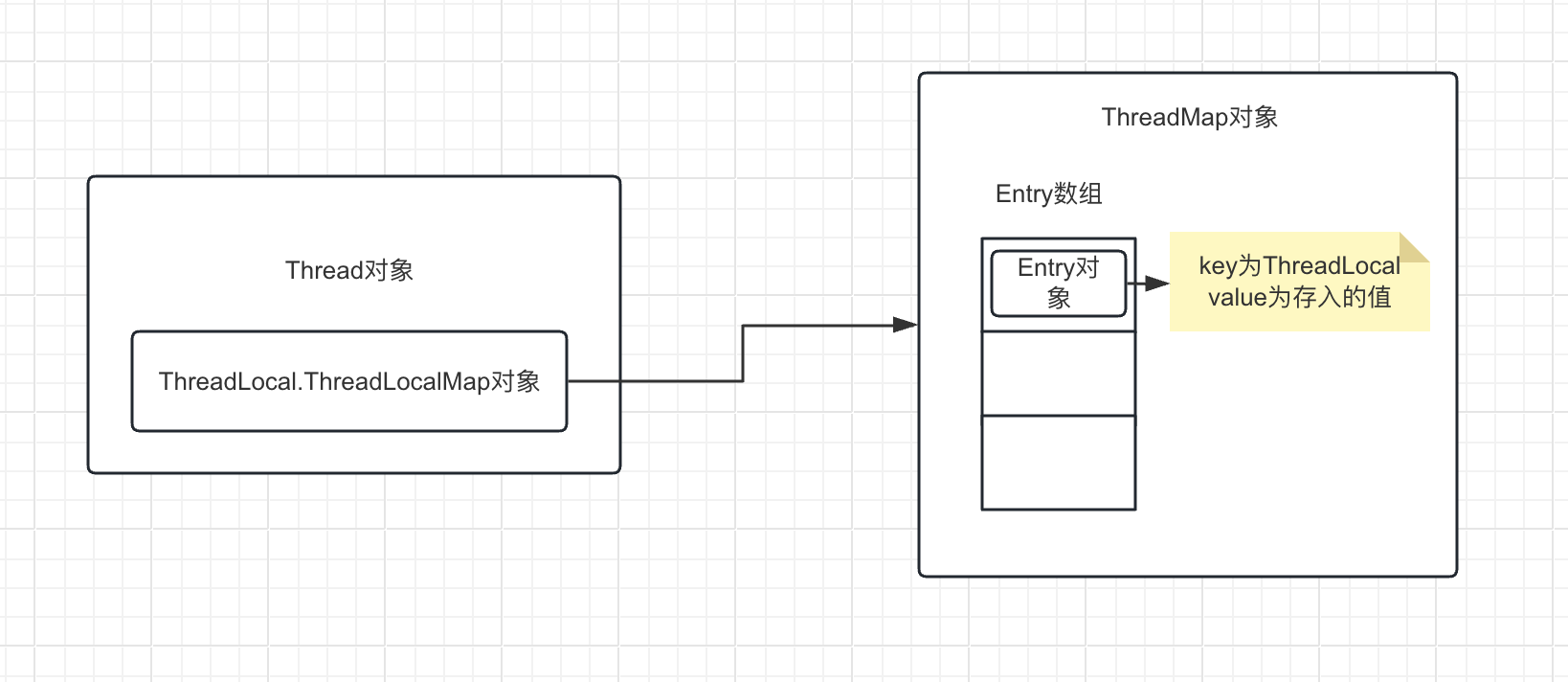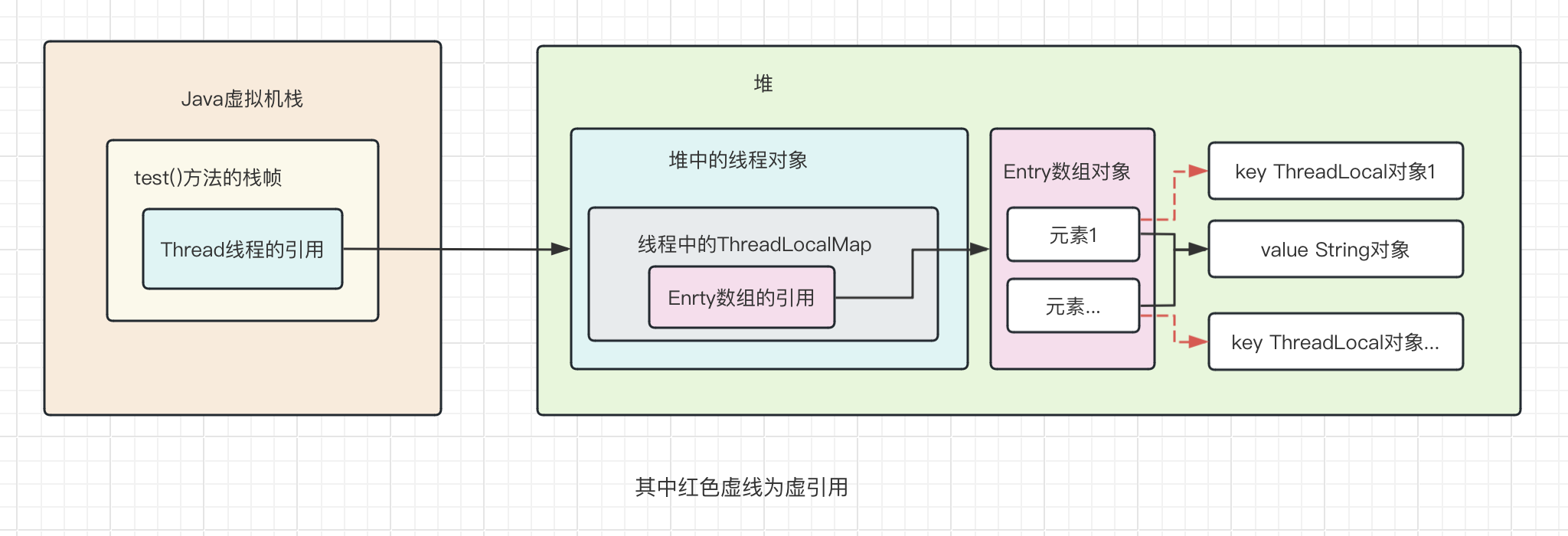一、ThreadLocal 数据结构
在日常的开发中,我们使用 ThreadLocal 的方式如下:
public class ThreadLocalTest {
// ThreadLocal variable to store each thread's ID
private static final ThreadLocal<Integer> threadId = ThreadLocal.withInitial(() -> (int) (Math.random() * 1000));
public static void main(String[] args) {
// Create multiple threads
Thread thread1 = new Thread(new Task(), "Thread-1");
Thread thread2 = new Thread(new Task(), "Thread-2");
Thread thread3 = new Thread(new Task(), "Thread-3");
// Start the threads
thread1.start();
thread2.start();
thread3.start();
}
// Task to be executed by each thread
static class Task implements Runnable {
@Override
public void run() {
// Get the thread's unique ID
Integer id = threadId.get();
System.out.println(Thread.currentThread().getName() + " has ID: " + id);
// Do some work
for (int i = 0; i < 5; i++) {
System.out.println(Thread.currentThread().getName() + " working with ID: " + id);
try {
Thread.sleep(100);
} catch (InterruptedException e) {
e.printStackTrace();
}
}
// Remove the thread-local variable
threadId.remove();
}
}
}
输出结果:
Thread-1 has ID: 911
Thread-1 working with ID: 911
Thread-3 has ID: 52
Thread-3 working with ID: 52
Thread-2 has ID: 687
Thread-2 working with ID: 687
Thread-3 working with ID: 52
Thread-1 working with ID: 911
Thread-2 working with ID: 687
Thread-3 working with ID: 52
Thread-1 working with ID: 911
Thread-2 working with ID: 687
Thread-2 working with ID: 687
Thread-1 working with ID: 911
Thread-3 working with ID: 52
Thread-2 working with ID: 687
Thread-3 working with ID: 52
Thread-1 working with ID: 911
Process finished with exit code 0
这一段代码含义:
- 定义了一个 ThreadLocal 变量为 threadId,对应的初始值为 0 到 1000 之间的随机数;
- 创建线程并启动,每个线程执行 Task 任务
- 在每个线程中使用 ThreadLocal 变量,每个线程从 ThreadLocal 的获取其唯一 ID 并打印出来;
- 模拟工作,例如操作数据库等;
- 移除 ThreadLocal 变量。
它们各个线程之间的数据不会出现错乱,那其底层是怎么实现的呢?其数据结构如下:
每一个 Thread 对象都有一个名为 threadLocals 的成员变量,对应的类型为 ThreadLocal.ThreadLocalMap。在 ThreadLocal.ThreadLocalMap 对象的内部有一个 Entry 数组,其中存储的 Entry 对象的 key 为 ThreadLocal,value 就是我们绑定到线程上的值。ThreadLocal 之所以可以做到线程间数据隔离,那是基于它每个线程内部都拥有一个独立的 ThreadLocalMap 对象,每个线程对自己的 ThreadLocalMap 对象进行操作不会影响到其他线程的数据。
二、源码学习
withInitial 设置初始值
/**
* Creates a thread local variable. The initial value of the variable is
* determined by invoking the {@code get} method on the {@code Supplier}.
*
* <p>创建线程局部变量。变量的初始值是通过调用Supplier上的get方法来确定的</p>
*
* @param <S> the type of the thread local's value 线程本地值的类型
* @param supplier the supplier to be used to determine the initial value
* <br>用于确认初始值的供应商
* @return a new thread local variable 一个新的线程局部变量
* @throws NullPointerException if the specified supplier is null
* @since 1.8
*/
public static <S> ThreadLocal<S> withInitial(Supplier<? extends S> supplier) {
return new SuppliedThreadLocal<>(supplier);
}
在上面的示例代码中就使用了 withInitial 进行设置 ThreadLocal 返回的初始值为 0 到 1000 之间的随机数。需要注意的是:如果该线程没有调用 set() 方法,那么第一次调用 get() 方法返回的就是这个设置的初始值,后续如果调用了 remove() 方法之后,再次调用 get() 方法也会返回这里设置的默认值(当然如果你设置的是随机数,那么返回的肯定不是同一个值)。
这里还有一个细节点就是使用了 Supplier,它有什么好处?先看看类的定义:
/**
* Represents a supplier of results.
* 代表结果供应商。
*
* <p>There is no requirement that a new or distinct result be returned each
* time the supplier is invoked.
* 不要求每次调用时都返回新的或独特的结果。这是一个功能接口,其功能方法是 get()。
*
* <p>This is a <a href="package-summary.html">functional interface</a>
* whose functional method is {@link #get()}.
*
* @param <T> the type of results supplied by this supplier
* 该供应商提供的结果类型代表结果供应商。
*
* @since 1.8
*/
@FunctionalInterface
public interface Supplier<T> {
/**
* Gets a result.
*
* @return a result
*/
T get();
}
这里能看到它只有一个 get() 方法用于获取结果。
set(T Value) 向 ThreadLocal 设置值
源码:
/**
* Sets the current thread's copy of this thread-local variable
* to the specified value. Most subclasses will have no need to
* override this method, relying solely on the {@link #initialValue}
* method to set the values of thread-locals.
*
* <p>将此线程本地变量的当前线程副本设置为指定值。大多数子类无需重载此方法,只需依赖 initialValue 方法来设置线程本地变量的值。
*
* @param value the value to be stored in the current thread's copy of
* this thread-local.
* <p>当前线程的线程本地变量副本中要存储的值
*/
public void set(T value) {
// 获取当前线程
Thread t = Thread.currentThread();
// 获取当前线程的ThreadLocal.ThreadLocalMap对象
ThreadLocalMap map = getMap(t);
// 如果ThreadLocalMap不为空,把key为自身ThreadLocal对象,value为要存放的值
if (map != null) {
map.set(this, value);
} else {
// 创建ThreadLocalMap,key为自身ThreadLocal对象,value为要存放的值
createMap(t, value);
}
}
ThreadLocalMap getMap(Thread t) {
return t.threadLocals;
}
void createMap(Thread t, T firstValue) {
t.threadLocals = new ThreadLocalMap(this, firstValue);
}
这里的逻辑就比较简单了,先获取到当前线程,然后调用 getMap() 方法,内部就是返回当前线程的 threadLocals 对象也就是 ThreadLocal.ThreadLocalMap,如果获取到的 threadLocals 不为空,则把 key 为自身 ThreadLocal 对象,value 为要存放的值;如果获取到的 threadLocals 为空,则调用 createMap() 方法进行创建 ThreadLocalMap 对象并把 key 为自身 ThreadLocal 对象,value 为要存放的值。
ThreadLocalMap#Entry
在上面的 set() 方法可以看到数据要么是调用 map.set() 或者 createMap() --> new ThreadLocalMap(this, firstValue) 方法,但是无论调用那种方式,最终数据都是保存到 Entry 数组里。那就来看看 Entry 的定义:
static class Entry extends WeakReference<ThreadLocal<?>> {
/** The value associated with this ThreadLocal. */
Object value;
Entry(ThreadLocal<?> k, Object v) {
super(k);
value = v;
}
}
这里看到 Entry 继承了 WeakReference 对象,这里有必须要提一下 Java 的四种引用,毕竟与 GC 有关,GC 会根据可达性分析算法,沿着 GC Roots 一直找到对象没有被其他对象引用,那代表该对象可以被 GC,但是这里的引用又分为四种:
- 强引用:普通的变量引用
public static User user = new User();
- 软引用:将对象用 SoftReference 软引用类型的对象包裹,正常情况不会被回收,但是 GC 做完后发现释放不出空间存放新的对象,则会把这些软引用的对象回收掉。软引用可用来实现内存敏感的高速缓存。
public static SoftReference<User> user = new SoftReference<User>(new User());
软引用在实际中有重要的应用,例如浏览器的后退按钮🔘。按后退时,这个后退时显示的网页内容是重新进行请求还是从缓存中取出呢?这就要看具体的实现策略了。
- 如果一个网页在浏览结束时就进行内容的回收,则按后退查看前面浏览过的页面时,需要重新构建。
- 如果将浏览过的网页存储到内存中会造成内存的大量浪费,甚至会造成内存溢出。
- 弱引用:将对象用 WeakReference 软引用类型的对象包裹,弱引用跟没引用查不到,GC 会直接回收掉,很少用。
public static WeakReference<User> user = new WeakReference<User>(new User());
- 虚引用:虚引用也称为幽灵引用或者幻影引用,它是最弱的一种引用关系,几乎不用。
那为什么这里 Entry 保存 ThreadLocal 类型的 key 需要使用弱引用?其实也是为了防止 OOM,如果 ThreadLocal 作为 Key 不使用弱引用,那么当前线程并没有结束,可以通过当前线程关联到其 threadLocals 属性对应的 ThreadLocalMap,再关联到 Entry 中的 ThreadLocal 对象,这时候 ThreadLocal 就无法被回收。
我们可以启动一个线程执行死循环,然后在里面无限创建 ThreadLocal 并设置值,看看这一段代码会不会出现 OOM。
public static void test() {
new Thread(() -> {
while (true) {
ThreadLocal<String> threadLocal = new ThreadLocal<>();
threadLocal.set("1");
}
}).start();
}
最终发现这一段代码并不会出现 OOM,这是因为 ThreadLocal 是弱引用指向,在发生 GC 的时候就会被回收。
细心的小伙伴会发现这里其实还有一个问题,虽然 ThreadLocal 被回收了,但是 Entry 数组一直在塞入 Entry,回收之后就相当于 Enrty 的 key 为 null,value 还是有值的,那么为什么不会出现 OOM 呢?原因就是万 ThreadLocalMap 塞入元素的时候,会删除过时的元素(也就是 Entry 中的 key 弱引用持有的 ThreadLocal 为 null 的元素)。
ThreadLocalMap 构造方法
ThreadLocalMap(ThreadLocal<?> firstKey, Object firstValue) {
// 初始化容量为16
table = new Entry[INITIAL_CAPACITY];
// hash散列获取下标
int i = firstKey.threadLocalHashCode & (INITIAL_CAPACITY - 1);
// 存入Entry数组中
table[i] = new Entry(firstKey, firstValue);
size = 1;
// 设置下一次扩容阈值 threshold = INITIAL_CAPACITY * 2 / 3;
setThreshold(INITIAL_CAPACITY);
}
这里就只需要留意两个点即可:
- 初始化 Entry 数组容量为 16;
- 设置的扩容阈值为 Entry 数组长度的 2/3。
ThreadLocalMap#set(ThreadLocal<?> key, Obejct value)
private void set(ThreadLocal<?> key, Object value) {
// We don't use a fast path as with get() because it is at
// least as common to use set() to create new entries as
// it is to replace existing ones, in which case, a fast
// path would fail more often than not.
Entry[] tab = table;
int len = tab.length;
int i = key.threadLocalHashCode & (len-1);
for (Entry e = tab[i];
e != null;
// 寻址:+1往后寻找,环状的遍历数组
e = tab[i = nextIndex(i, len)]) {
ThreadLocal<?> k = e.get();
// 相同的key直接覆盖
if (k == key) {
e.value = value;
return;
}
if (k == null) {
replaceStaleEntry(key, value, i);
return;
}
}
tab[i] = new Entry(key, value);
int sz = ++size;
if (!cleanSomeSlots(i, sz) && sz >= threshold)
rehash();
}
从上面来看 ThreadLocalMap#set 方法可以分为两步:
- 从开放寻址的方式找到合适的位置进行存储数据;
- 向数组中放入新的 Entry,有需要的话会进行扩容。
开放寻址的方式找到合适的位置进行存储数据
这一步的代码是在这个 for 循环里面:
Entry[] tab = table;
int len = tab.length;
int i = key.threadLocalHashCode & (len-1);
for (Entry e = tab[i];
e != null;
// 寻址:+1往后寻找,环状的遍历数组
e = tab[i = nextIndex(i, len)]) {
ThreadLocal<?> k = e.get();
// 相同的key直接覆盖
if (k == key) {
e.value = value;
return;
}
if (k == null) {
replaceStaleEntry(key, value, i);
return;
}
}
对应的 nextIndex 代码如下:
private static int nextIndex(int i, int len) {
return ((i + 1 < len) ? i + 1 : 0);
}
这是啥意思呢?分析如下所示:
总结:
- ThreadLocalMap#set 方法通过 for 循环遍历,直到在 Entry 数组中找到一个为 null 的位置或者是两个 key 相同进行覆盖原来的值才会跳出 for 循环;
- 第一个 if 意味着相同的 ThreadLocal 会进行覆盖之前的旧值;
- 第二个 if 意味着原来霸占着 Entry 数组这个位置的 ThreadLocal 因为是弱引用类型从而被 GC 垃圾回收了,但是为了避免对应的 value 值没有被回收导致内存泄漏的问题,这里就通过 replaceStaleEntry 进行覆盖。
向数组中放入新的 Entry,有需要的话会进行扩容
在上面 for 循环中进行的条件是 e != null,e 是 Enrty 数组中的元素,那么 for 循环结束的时候,除了成功覆盖了原有的元素的情况,还有就是找到了一个可以使用的位置。此时逻辑如下:
// 插入的新的Enrty
tab[i] = new Entry(key, value);
// 数组大小++
int sz = ++size;
// 调用cleanSomeSlots尝试清理一些未在使用的位置,如果清理失败则调用rehash进行扩容
if (!cleanSomeSlots(i, sz) && sz >= threshold)
rehash();
我们能看到进行 rehash 需要满足两个条件:
- cleanSomeSlots 方法进行清理一些未在使用的位置失败,也就代表着在 Entry 数组中没有因为 GC 而导致的 ThreadLocal 被清除的情况;
- 数组的大小大于扩容的阈值(在上面我们说过扩容的阈值为 Entry 数组容量的 2/3)
感兴趣的小伙伴可以自己去看看 cleanSomeSlots 的代码,这里就不分析了。下面就来看看 rehash 的代码:
private void rehash() {
// 删除过时的条目
expungeStaleEntries();
// Use lower threshold for doubling to avoid hysteresis
// 使用较低的加倍阈值以避免滞后
if (size >= threshold - threshold / 4)
resize();
}
/**
* Double the capacity of the table.
*/
private void resize() {
Entry[] oldTab = table;
int oldLen = oldTab.length;
// 扩容为原来的两倍
int newLen = oldLen * 2;
Entry[] newTab = new Entry[newLen];
int count = 0;
for (int j = 0; j < oldLen; ++j) {
Entry e = oldTab[j];
if (e != null) {
ThreadLocal<?> k = e.get();
// 如果对应的ThreadLocal被回收了,那么对应的value也进行删除
if (k == null) {
e.value = null; // Help the GC
} else {
// 开放式寻址找到合适的位置进行存放
int h = k.threadLocalHashCode & (newLen - 1);
while (newTab[h] != null)
h = nextIndex(h, newLen);
newTab[h] = e;
count++;
}
}
}
// 修改扩容阈值
setThreshold(newLen);
// 设置size为有效的个数
size = count;
table = newTab;
}
总结:
- 先清除过时的条目;
- 进行扩容为原来的两倍,并把旧的数据从旧的 Entry 数组拷贝到新的 Enrty 数组中:
- 如果 key 为 null(也就是 ThreadLocal 被 GC 回收了),那么把对应的 value 值也设置为 null(从而没有地方引用了对应的 vaule),方便 GC 回收;
- 通过开放式寻址的方式找到合适的位置存放对应的元素。
ThreadLocal#get() 获取当前线程绑定到 ThreadLocal 上的值
public T get() {
Thread t = Thread.currentThread();
// 获取当前线程的ThreadLocalMap
ThreadLocalMap map = getMap(t);
if (map != null) {
// 已当前ThreadLocal作为key找到对应存放的值
ThreadLocalMap.Entry e = map.getEntry(this);
// 如果不为空,则直接返回
if (e != null) {
@SuppressWarnings("unchecked")
T result = (T)e.value;
return result;
}
}
// 如果没有找到,或者当前线程的ThreadLocalMap为null,调用setInitialValue返回默认值
return setInitialValue();
}
这部分代码可以分成两部分:
- 获取 ThreadLocalMap 中的值;
- 如果没有设置 ThreadLocalMap,则调用 setInitialValue 进行返回默认值。
获取 ThreadLocalMap 中的值
我们从上面的代码能看到通过 ThreadLocal 为 key 进行获取 ThreadLocalMap 的值的代码在 getEntry 中:
private Entry getEntry(ThreadLocal<?> key) {
int i = key.threadLocalHashCode & (table.length - 1);
Entry e = table[i];
// 如果获取的e不为空,并且对应的key为当前ThreadLocal,那直接返回对应值
if (e != null && e.get() == key)
return e;
else
// 如果没有值,或者ThreadLocal和当前的key不相等,那么调用开放性寻址的方式去寻找
return getEntryAfterMiss(key, i, e);
}
// getEntryAfterMiss
private Entry getEntryAfterMiss(ThreadLocal<?> key, int i, Entry e) {
Entry[] tab = table;
int len = tab.length;
while (e != null) {
// 获取到对应的ThreadLocal
ThreadLocal<?> k = e.get();
// 和当前的ThreadLocal相等则返回
if (k == key)
return e;
// 如果ThreadLocal已经被GC回收,则清理被回收的元素
if (k == null)
expungeStaleEntry(i);
else
// 开放性寻址,寻址在一个位置
i = nextIndex(i, len);
// 重新获取值
e = tab[i];
}
// 如果还是没找到,那就代表之前没有调用set方法存放过值
return null;
}
总结:
- 先获取到当前 ThreadLocal 在 Entry 数组中存放的位置 i;
- 通过下标获取到对应的 Entry,如果 Entry 不为空并且对应的 key 等于当前 ThreadLocal,则直接返回对应的 Entry;
- 如果没有值或者对应的 Entry 的 key 不等于当前 ThreadLocal,那么调用 getEntryAfterMiss 方法进行开放性寻址的方式进行获取对应的值;
- 判断当前 Entry 的 key 是否等于当前 ThreadLocal,相等则直接返回;
- 如果 ThreadLocal 已经被 GC 回收,则清理被回收的元素;
- 还找不到,则继续通过开放性寻址的方式进行获取下一个下标,从而获取到对应的 Entry 进行走上面的逻辑;
- 最后还是找不到则返回 null,代表之前就没有调用 set 方法进行存储过值。
如果没有设置 ThreadLocalMap
如果没有设置 ThreadLocalMap,则调用 setInitialValue 进行返回默认值。
private T setInitialValue() {
// 子类可以自定义实现这个类用于设置默认值,默认情况下可以使用SuppliedThreadLocal这个类
// 也就是直接使用ThreadLocal#withInitial方法进行设置默认值
T value = initialValue();
Thread t = Thread.currentThread();
ThreadLocalMap map = getMap(t);
if (map != null) {
map.set(this, value);
} else {
createMap(t, value);
}
if (this instanceof TerminatingThreadLocal) {
TerminatingThreadLocal.register((TerminatingThreadLocal<?>) this);
}
return value;
}
这里子类可以直接去实现 ThreadLocal 然后重写 initialValue 方法,用于返回默认值。这里有一个默认的实现类 SuppliedThreadLocal:
static final class SuppliedThreadLocal<T> extends ThreadLocal<T> {
private final Supplier<? extends T> supplier;
SuppliedThreadLocal(Supplier<? extends T> supplier) {
this.supplier = Objects.requireNonNull(supplier);
}
@Override
protected T initialValue() {
return supplier.get();
}
}
看到构造方法入参是一个 Supplier,也就是可以按照下面的方式进行设置默认值:
private static final ThreadLocal<Integer> threadId = ThreadLocal.withInitial(() -> 100);
这里示例代码是设置每个 ThreadLocal 的默认值为 100,当然你可以根据实际业务情况设置。





















 322
322

 被折叠的 条评论
为什么被折叠?
被折叠的 条评论
为什么被折叠?








